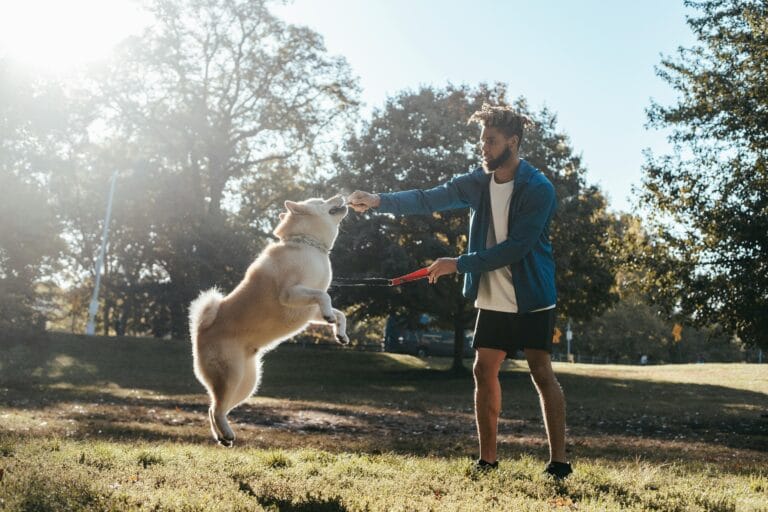Introduction to Autism in Dogs
In recent years, pet owners and veterinarians alike have begun to explore fascinating questions about the mental health of our four-legged friends. One of the most compelling inquiries is: can dogs have autism? The curiosity surrounding “autistic dogs” has become more prominent, as many owners notice unusual behaviors in their pets. Whether it’s obsessive habits, social avoidance, or reactions to changes in their environment, some of these actions resemble autism symptoms in humans. But what does science say about autism-like behaviors in dogs?
Understanding these behaviors in our pets can help improve their quality of life, and in this article, we’ll explore 12 fascinating insights about autism in dogs, signs of autism-like symptoms, the possible causes, and how to support these unique animals.
Table of Contents
What We Mean by “Autistic Dogs”
When we talk about dogs showing “autism-like” behaviors, it’s important to note that this is not an official diagnosis. Unlike in human psychiatry, where Autism Spectrum Disorder (ASD) is well-defined and clinically recognized, there is no formal equivalent in veterinary medicine. Instead, behaviors that resemble autism in dogs fall under what veterinarians call Canine Dysfunctional Behavior (CDB). These behaviors may mimic the signs of autism, but they are not the same condition as ASD in humans.
So, what exactly is Canine Dysfunctional Behavior? And do dogs have autism, or is it something else entirely?
Autism Spectrum Disorder (ASD) in Humans: A Quick Overview
To understand autism-like behaviors in dogs, let’s first take a brief look at what autism entails in humans. Autism Spectrum Disorder is a complex neurological condition characterized by challenges with social communication and restricted, repetitive behaviors. Some of the main criteria used to diagnose ASD include:
- Social Communication Difficulties: People with autism may struggle to interpret social cues, leading to challenges in interacting with others.
- Restricted and Repetitive Behaviors: These can range from repetitive body movements to strict routines and focused interests.
- Sensory Sensitivities: Individuals with autism might be sensitive to sounds, textures, or changes in their environment.
Diagnosing autism in humans is a complex process and requires a trained specialist. Given the variety of ways autism presents in people, it’s easy to see why applying similar standards to animals could be problematic. But still, the question lingers: can dogs have autism? And if they can, what does that look like?

How Do Dogs Communicate and Socialize?
Dogs are highly social animals but communicate and behave differently from humans. They rely on body language, vocalizations, and scent marking rather than verbal cues. Unlike people, who might demonstrate social skills verbally, dogs show it through behaviors like play, tail wagging, and facial expressions. This is why diagnosing “autistic” behaviors in dogs requires a deeper understanding of what is considered typical for their species. Still, with the growing question, do dogs have autism, owners and veterinarians alike are looking for clearer signs and explanations.
Signs of Autism in Dogs: Understanding Canine Dysfunctional Behavior
Veterinarians look for certain behaviors in dogs that resemble symptoms of autism. These signs can vary widely and might be more common in certain breeds. Here are some of the primary behaviors associated with Canine Dysfunctional Behavior:
1. Repetitive Movements or Actions
One of the hallmark behaviors associated with autism-like symptoms in dogs is repetitive actions. This could include obsessive tail-chasing, excessive licking, or pacing. Just like repetitive body movements in humans with autism, dogs may engage in these actions as a way to self-soothe.
2. Social Withdrawal and Avoidance
Some dogs with autism-like behaviors may seem to avoid social interactions. They might not respond to typical bonding cues, like petting or calling their name. Instead, they might prefer being alone, a behavior that could be seen as social withdrawal. This often leads owners to question, do dogs have autism, as these behaviors are somewhat reminiscent of ASD in humans.
3. Hypersensitivity to Environmental Changes
Dogs displaying autism-like symptoms can be hypersensitive to changes in their environment. This sensitivity can manifest as intense reactions to loud noises, changes in their routine, or even new people in their space. This is another reason pet owners may wonder, can dogs have autism, as such sensitivity is also common in humans on the autism spectrum.
4. Lack of Playfulness or Interest in Toys
While most dogs enjoy playing with toys or engaging in interactive play with their owners, dogs with autism-like behaviors may seem uninterested in playtime. Their lack of engagement can make them seem detached or overly passive. This behavior is another factor that contributes to the growing debate about whether dogs can truly have autism.
5. Lack of Eye Contact
In humans, lack of eye contact can be a sign of autism, and some owners report that dogs with autism-like traits exhibit a similar avoidance. They may look away or avoid making direct eye contact with people, especially in new or stressful situations, which brings us back to the question: do dogs have autism?

Canine Breeds More Prone to Autism-like Behaviors
Some research suggests that certain dog breeds might be more prone to exhibiting behaviors that resemble autism. Bull Terriers, for instance, have been known to show repetitive tail-chasing and other behaviors linked to Canine Dysfunctional Behavior. This raises the question of whether genetics might play a role, as these traits appear more frequently in specific breeds. So, if you’ve wondered, can dogs have autism, it may depend on the breed’s genetic tendencies.
Research on Autism-like Behavior in Dogs
Research into autism-like behaviors in dogs is limited, but a few studies have provided intriguing insights. Dr. Nicholas Dodman, a veterinary behaviorist, has conducted research focusing on Bull Terriers that display repetitive tail-chasing behaviors. His findings suggest that these behaviors might be more than simple quirks, potentially sharing common biological markers with ASD in humans.
Elevated Protein Levels in Dogs and ASD Parallels
Another significant study found that tail-chasing Bull Terriers had elevated levels of two proteins—neurotensin and corticotropin-releasing hormone (CRH)—which are also higher in children with autism. This biological similarity is intriguing and fuels the debate over whether dogs can truly have autism or simply exhibit similar behaviors.
Is My Dog Autistic? Signs and Self-Check
Wondering if your dog might be showing autism-like traits? Here are a few signs to consider when asking yourself, can dogs have autism:
- Does your dog engage in repetitive behaviors, such as tail-chasing or excessive licking?
- Does your dog avoid eye contact or seem detached from social interactions?
- Is your dog hypersensitive to changes in the environment, like noises or new people?
- Does your dog show limited interest in toys or games?
If you notice these behaviors and they seem to affect your dog’s quality of life, consulting with a veterinarian specializing in behavior might be helpful.

Autism vs. ADHD in Dogs: What’s the Difference?
Like humans, dogs can exhibit behaviors that resemble ADHD, or Attention Deficit Hyperactivity Disorder. ADHD in dogs might look like impulsiveness, restlessness, and difficulty focusing. While dogs don’t receive formal ADHD or autism diagnoses, it’s useful to understand the behaviors associated with each condition and continue exploring whether dogs can have autism.
Signs of ADHD in Dogs
Common signs of ADHD in dogs include:
- Excessive energy and difficulty calming down
- Impulsivity or lack of impulse control
- Difficulty focusing on commands or tasks
It’s important to note that these behaviors can vary between breeds and individual dogs, making a formal diagnosis challenging. Instead, veterinarians focus on helping owners manage and modify these behaviors, which leaves the question of can dogs have autism as a distinct issue.
Possible Causes of Autism-like Symptoms in Dogs
While we don’t have concrete answers about why some dogs display autism-like behaviors, there are several theories worth considering as we continue to explore whether dogs can have autism.
1. Genetic Predispositions
Certain breeds may have a genetic predisposition to behaviors associated with autism-like symptoms. For example, the repetitive tail-chasing observed in Bull Terriers may be linked to genetics, which continues to support the theory that dogs can have autism-like traits based on heredity.
2. Environmental Influences
Early life experiences can play a significant role in a dog’s behavior. Dogs that lack socialization or experience trauma at a young age may develop unusual behavioral traits later in life. This environmental influence can contribute to behaviors that mimic autism, leading to the belief that do dogs have autism or at least autism-like tendencies.
3. Neurological and Chemical Factors
As mentioned in the study above, certain dogs have elevated levels of neurotensin and CRH. These chemicals might be linked to repetitive behaviors and could be a factor in Canine Dysfunctional Behavior, fueling further debate over whether dogs can have autism in a true sense.
Treatment for Autism-like Symptoms in Dogs
While there is no cure for autism in dogs, several treatments can help manage autism-like symptoms and improve your dog’s quality of life, answering concerns around how to help dogs with autism-like behaviors.
Behavioral Therapy and Environmental Enrichment
Structured environments and routines can help dogs with autism-like behaviors feel more secure. Behavioral therapy can help teach dogs new coping mechanisms, especially when combined with environmental enrichment activities, like puzzle toys and interactive games.
Medications and Supplements for Calming
In severe cases, a veterinarian might recommend medications or supplements to help calm a dog’s nerves. These are not specifically for autism but can help reduce anxiety and repetitive behaviors.
Positive Reinforcement and Patience
Positive reinforcement training is crucial when working with a dog that exhibits autism-like behaviors. Rewards-based training, using treats and praise, helps reinforce desired actions while reducing stress.

Special Needs in Dogs Beyond Autism
Some dogs have special needs due to physical, mental, or behavioral challenges. Dogs with special needs might require additional care, whether it’s related to mobility, vision, or behavior.
Common Special Needs in Dogs and How to Support Them
Special needs can encompass many issues, from physical disabilities to behavioral conditions like Canine Dysfunctional Behavior. Supporting a special needs dog requires patience, consistency, and often a customized care plan. Many owners find that working closely with a veterinarian helps them develop the best approach for their pet’s specific needs.
How to Help a Dog with Autism-like Behaviors Thrive
Owning a dog with autism-like behaviors can be challenging, but there are many ways to help these pets live fulfilling lives:
- Establish a Routine: Dogs thrive on predictability. A set routine reduces anxiety and helps them adjust to daily activities.
- Provide a Safe Space: Create a quiet, comfortable area where your dog can retreat. This space can offer a refuge during stressful situations, like loud noises or social gatherings.
- Engage in Regular Exercise: Physical activity is essential for dogs with autism-like behaviors, as it helps relieve stress and reduces anxiety.
- Use Interactive Toys: Puzzles and interactive toys encourage mental stimulation, which can help redirect repetitive behaviors.
- Consider Consulting a Behaviorist: Professional advice from a behaviorist or a vet specializing in canine behavior can provide personalized guidance.
Conclusion
While dogs don’t get diagnosed with autism as humans do, they can display autism-like behaviors grouped under Canine Dysfunctional Behavior. By recognizing these signs, providing support, and understanding your pet’s unique needs, you can create a supportive environment that allows your dog to thrive.
FAQs
What are signs of autism in dogs? Signs include repetitive behaviors, social withdrawal, hypersensitivity, and lack of interest in play.
Can dogs have ADHD or autism? Dogs can show ADHD- and autism-like traits, though they are not formally diagnosed as such.
What is an autistic dog called? There’s no formal term, but dogs showing autism-like behaviors are often said to have Canine Dysfunctional Behavior.
Can dogs be special needs? Yes, dogs can have various special needs due to behavioral or physical conditions.
How do you care for a dog with autism-like behaviors? Establish routines, create safe spaces, use positive reinforcement, and consult with a vet or behaviorist.





